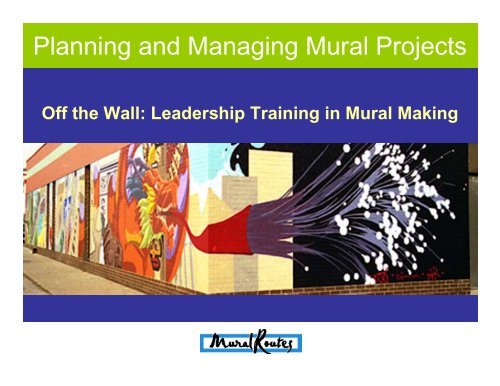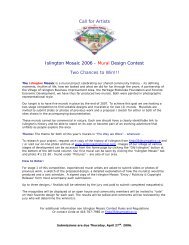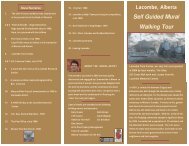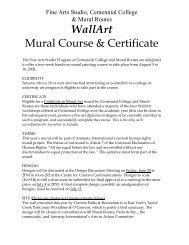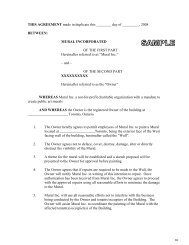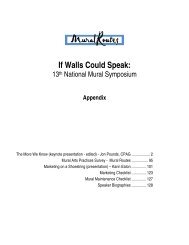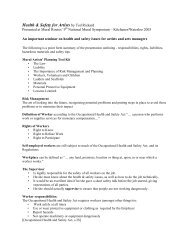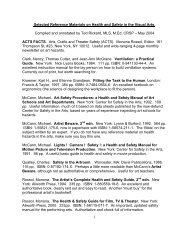Planning and Managing Mural Projects - Mural Routes
Planning and Managing Mural Projects - Mural Routes
Planning and Managing Mural Projects - Mural Routes
You also want an ePaper? Increase the reach of your titles
YUMPU automatically turns print PDFs into web optimized ePapers that Google loves.
<strong>Planning</strong> <strong>and</strong> <strong>Managing</strong> <strong>Mural</strong> <strong>Projects</strong><br />
Off the Wall: Leadership Training in <strong>Mural</strong> Making
<strong>Planning</strong> <strong>and</strong> <strong>Managing</strong> <strong>Mural</strong> <strong>Projects</strong><br />
Toronto context<br />
More than 20 groups create<br />
murals around the City each<br />
summer.
What is Project Management?<br />
"A discipline which requires budgeting, planning <strong>and</strong> resource<br />
management skills to enable a specified end deliverable to be<br />
completed within the allocated timeframe".<br />
www.my-project-management–expert.com<br />
Karin’s definition<br />
“Budgeting, <strong>Planning</strong>, Organizing, Scheduling,<br />
Supervising……..<br />
everything that needs to be done to get a project<br />
completed as agreed by all parties……..<br />
ON TIME <strong>and</strong> WITHIN BUDGET”
What is Project Management?<br />
Budgeting, <strong>Planning</strong>, Organizing, Scheduling,<br />
Supervising……..<br />
everything that needs to be done to get a<br />
project completed as agreed by all parties……..<br />
ON TIME <strong>and</strong> WITHIN BUDGET
What is Project Management?<br />
Key words:<br />
Knowledge of the project<br />
Time management<br />
Communication<br />
Decision making<br />
Troubleshooting
INITIATING THE MURAL PROJECT<br />
Client<br />
• Set Criteria<br />
• Secure community<br />
partners<br />
• Secure funding<br />
• Find a wall<br />
• Choose a theme<br />
• Select an artist<br />
• Negotiate the fee<br />
• Create a contract<br />
Artist<br />
• Set personal criteria<br />
• Secure a client<br />
• Negotiate the fee<br />
• Secure a contract
Setting Criteria – in the beginning<br />
Before starting a mural or mural project, ask these important questions:<br />
• What do you want to accomplish by creating this mural?<br />
• How will the mural be paid for?<br />
• Are you accountable to a private client, a committee, the public?<br />
• OR.. Can you make decisions on your own?<br />
• Is this part of a larger project?<br />
• Do you have the experience <strong>and</strong> the commitment of time <strong>and</strong> energy?<br />
• Who takes final responsibility for the mural?<br />
The mural “A Sense of Place” by Frank Perna<br />
1997 was painted outside the Kennedy Subway<br />
Station in Toronto as a result of a community<br />
safety audit.<br />
The purpose was to create a space that would<br />
increase the comfort level of pedestrians <strong>and</strong><br />
commuters.
Community Involvement<br />
The most lasting <strong>and</strong> successful mural projects have a connection with the<br />
local community. There are many opportunities for community involvement<br />
on planning committees, fundraisers, artist liaison or “cheer leaders.”<br />
For the artist, it is a great advantage to have this kind of community support.<br />
• Community outreach<br />
• Community Consultation<br />
• Community Celebration
Funding options for community murals<br />
1) Grants<br />
2) Donations & sponsorships<br />
3) Fundraising events<br />
4) Earned revenue through the sale of<br />
merch<strong>and</strong>ise; prints, posters, cards,<br />
calendars etc.<br />
5) Lottery funding (Nevada, bingo, raffles)<br />
6) Donations of goods <strong>and</strong> services<br />
7) Other………
Selecting a wall or mural site<br />
Consider these things:<br />
• Visibility – minimal visual distractions, good view for the public<br />
• Wall construction – what is it made of?<br />
• Wall condition <strong>and</strong> environment<br />
• Wall surface<br />
• Ownership
Selecting a wall or mural site<br />
<strong>Mural</strong>s can also be created on panels <strong>and</strong> installed on the walls.<br />
Materials include: Marine grade plywood, Sign board (Crezone) <strong>and</strong> Dibond<br />
(Aluminum)<br />
Marine Grade Plywood<br />
Dibond
Selecting a wall or mural site<br />
Some of the potential hazards to the life of a mural include:<br />
• Damp in the wall or from the roof<br />
• Ground water <strong>and</strong> snow build-up<br />
• Poor construction<br />
• Old brick<br />
• Slick surface
Choosing a Theme or Subject<br />
The theme of the mural should be chosen by considering:<br />
• Relevance to the mural location<br />
• Purpose of the mural project<br />
• Significance to the community being impacted<br />
• Artistic expression<br />
In rare cases the artists are given freedom to choose the subject themselves<br />
Artist Bill Wrigley was given artistic freedom to choose his subject<br />
for this extremely challenging underpass site – “Kidsplay”, 2006
Selecting the Artist<br />
Ways to select an artist<br />
• Competition (open, invitational or limited to a category of artist)<br />
• Call of Interest<br />
• Commission<br />
Competition Brief or Call for Artists should include:<br />
• Size <strong>and</strong> location of the wall<br />
• Theme or other considerations for subject matter<br />
• Fee or request for budget<br />
• Expectations <strong>and</strong> roles of the artist<br />
• Roles of the Client<br />
• Information about the Client organization<br />
• Application process
Getting a <strong>Mural</strong> Commission<br />
Competitions – Word of Mouth – Developing a reputation <strong>and</strong> client base<br />
IN MURAL PAINTING, EXPERIENCE COUNTS<br />
Some helpful hints for responding to competition applications:<br />
1. READ the competition brief THOROUGHLY<br />
2. Include EVERYTHING that is requested in the application<br />
3. Create a PROFESSIONAL looking PORTFOLIO<br />
4. Include your most RELEVANT experience in the application<br />
5. Write a letter that shows ENTHUSIASM for the project<br />
6. BE ON TIME FOR INTERVIEWS<br />
7. Prepare some QUESTIONS for the interview<br />
8. Demonstrate an ability to COMPLETE the work ON TIME<br />
9. If a SKETCH is required, GO THE EXTRA MILE, add COLOUR or<br />
CONTEXT<br />
10. Even if you don’t get the job, keep a good relationship with the client –<br />
THEY MAY HAVE OTHER MURALS IN THE FUTURE
ADMINISTRATION & PROJECT MANAGEMENT<br />
• ADMINSTRATOR’S ROLES<br />
• Budget & Financial Management<br />
• Site Selection<br />
• Artists’ selection<br />
• Contracts <strong>and</strong> Permits<br />
• Human Resources<br />
• Insurance<br />
• Health & Safety Concerns<br />
• Reporting & communication<br />
• Events <strong>and</strong> Celebration<br />
• Promotion<br />
• Maintenance schedule<br />
PROJECT MANAGER’S ROLES<br />
• Liaison with artists/ clients/ partners<br />
• Scheduling – time management<br />
• Day to day supervision<br />
• Troubleshooting<br />
• Public relations & media relations<br />
• Event Management<br />
• Reporting & communication<br />
Frequently the Artist is the Project Manager<br />
The roles of Administrator <strong>and</strong> Project Manager may vary, but it is<br />
important to appoint one person to be the liaison with the artist <strong>and</strong><br />
the client, community or owner of the wall.
Budget<br />
Developing the budget requires attention to detail.<br />
INCLUDE:<br />
• Administration expenses<br />
• Project Management costs<br />
• Design fee / maquette<br />
• Competition costs<br />
• Artists’ fees<br />
• Health & Safety measures<br />
• Insurance<br />
• Permit fees<br />
• Wall preparation<br />
• Paint, brushes <strong>and</strong> other materials<br />
• Scaffolding, ladders or other lifting equipment<br />
• Signage / identification<br />
• Promotion including mural launch <strong>and</strong> website update<br />
• MAINTENANCE<br />
Important considerations before setting<br />
the budget<br />
1) Quality of the mural desired.<br />
2) Size, location <strong>and</strong> condition of the wall(s).<br />
3) Selection process for the artist.
Artists’ fees<br />
Considerations to take into account:<br />
• Artist’s experience<br />
• Size of the mural<br />
• Complexity of the Site<br />
• Expectations <strong>and</strong> roles of the artist<br />
• Individual criteria<br />
• Available funding<br />
• Industry st<strong>and</strong>ard
Contracts<br />
Written contracts help clarify the roles <strong>and</strong> responsibilities between the<br />
artist <strong>and</strong> the client <strong>and</strong> set the terms of engagement.<br />
A checklist of items to be covered:<br />
Liability – who is responsible for insurance <strong>and</strong> onsite supervision?<br />
Resource person – who has authority to make decisions?<br />
Working conditions – timeline, provision for bad weather etc.<br />
Division of responsibility – roles <strong>and</strong> expectations of each party<br />
Copyright – are there any waivers?<br />
Fees <strong>and</strong> payment schedule.<br />
Artists’ Contracts – Agreements for Visual <strong>and</strong> Media Artists<br />
By Paul S<strong>and</strong>erson & Ronald N. Hier<br />
Published by CARCAC Ontario<br />
http://www.carfac.ca/
Copyright<br />
Copyright laws are extremely complicated.<br />
Simplified – but only as a guideline:<br />
• If you create an original artistic work, you own the copyright<br />
• This is essentially an economic right to reproduce you artistic image<br />
• The Copyright Act protects forms of artistic expression, such as a mural, but<br />
not ideas<br />
• You can waive copyright<br />
• Moral Rights exist side by side with Copyright <strong>and</strong> deal with Integrity <strong>and</strong><br />
Paternity<br />
• Many organizations ask artists to give the right to reproduce images for<br />
PROMOTIONAL purposes<br />
• Some organizations ask artists to waive all copyright so that they do not<br />
benefit from sales of reproductions<br />
KNOW YOUR RIGHTS AS AN ARTIST<br />
Canadian Copyright Act<br />
http://www.cb-cda.gc.ca/info/act-e.html
Insurance<br />
Personal Accident Insurance - coverage in case of a work injury<br />
Usually the responsibility of the artist.<br />
Third Party Liability Insurance – coverage in case of injury to a third party<br />
Usually the responsibility of the group or business managing the project.<br />
If the artist is on payroll, insurance will be required through Workers Safety <strong>and</strong><br />
Insurance Board (WSIB) or other similar coverage.
Health & Safety<br />
RISK MANAGEMENT IS OF PRIME IMPORTANCE ON A MURAL SITE<br />
Learn to recognize potential problems <strong>and</strong> put steps in place to avoid those<br />
problems or to minimize their impact.<br />
SOME BASIC POINTS:<br />
• Good planning is needed to minimize on-site hazards<br />
• Keep the site clean – tidy up all loose items<br />
• Be aware of toxic paints <strong>and</strong> solvents – always read the labels<br />
• Scaffolding requires knowledge to construct <strong>and</strong> use properly<br />
• Above 3 metres (10 feet) fall arrest equipment is needed.<br />
• Ladders should be used with caution<br />
• Lift equipment such as scissor lifts or swing stages, require special training<br />
• Use protection from extreme temperatures<br />
• You are at greater risk when you are tired<br />
• WHMIS – Workplace Hazardous Materials Information System is Canada’s<br />
national hazard communication st<strong>and</strong>ard<br />
http://www.hc-sc.gc.ca/ewh-semt/occup-travail/whmis-simdut/index_e.html/
CREATING THE MURAL<br />
Design<br />
Wall preparation<br />
Painting
Design<br />
Sketch - Maquette - <strong>Mural</strong><br />
Ensure there is time <strong>and</strong> space for the design process
Wall Preparation<br />
Fixing – Cleaning - Priming<br />
QUESTIONS<br />
What is the substrate?<br />
What prep has to be done?<br />
Can the artist do this work or<br />
do you have to hire a<br />
specialist?
Painting
CLOSURE<br />
After the long process of planning, designing, managing <strong>and</strong> painting a mural<br />
the process ends when:<br />
1. The artist is satisfied <strong>and</strong> declares the mural complete<br />
2. The client inspects <strong>and</strong> accepts the mural as completed<br />
3. Final payment is made to the artist<br />
4. A mural launch or unveiling is held to celebrate the work (optional)<br />
5. There may still be obligations for maintenance, depending on the contract
Useful Resources<br />
<strong>Mural</strong> <strong>Routes</strong> www.muralroutes.com<br />
• <strong>Mural</strong> Production: A resource h<strong>and</strong>book<br />
• Workshops & Symposia<br />
• <strong>Mural</strong> Map of Canada<br />
• Community Consultation<br />
• Community <strong>Mural</strong> <strong>Projects</strong><br />
Visual Arts Ontario www.vao.org/<br />
• Call for Artists<br />
• Professional advice <strong>and</strong> workshops<br />
CARFAC www.carfac.ca<br />
• Copyright <strong>and</strong> contract information<br />
• Professional st<strong>and</strong>ards<br />
www.hc-sc.gc.ca/ewh-semt/occup-travail/whmis-simdut/index_e.html/
<strong>Planning</strong> <strong>and</strong> <strong>Managing</strong> <strong>Mural</strong>s<br />
Presented by Karin Eaton<br />
<strong>Mural</strong> <strong>Routes</strong><br />
1859 Kingston Road, Toronto, ON M1N 1T3<br />
www.muralroutes.com<br />
info@muralroutes.com<br />
416-698-7995<br />
Improving communities through mural art


